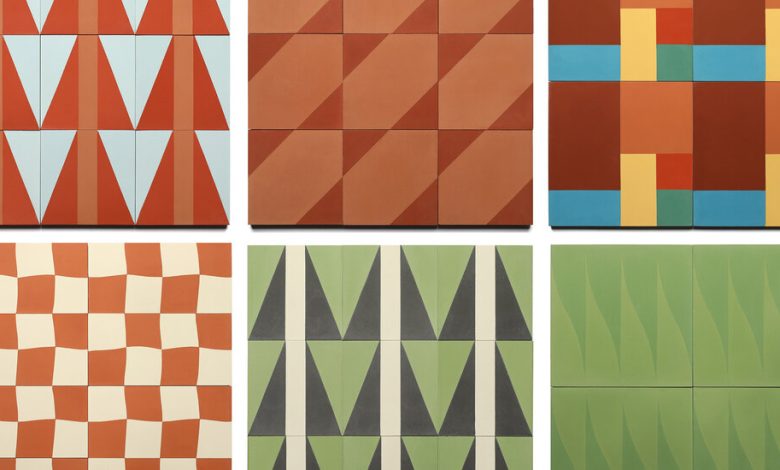Artisanal Cement Tiles Inspired by Modernist Homes

Covet This
Rugs That Conjure an Ancient Garden in Kabul

Left: a view of Bamiyan, Afghanistan, where some of the artisans employed by the London-based company Ishkar artisans work. Right: a hand-knotted Ghazni wool rug, titled Kabul Sunset Bouquet, designed by Louis Barthélemy for Ishkar. Credit…Left: Glen Wilde. Right: courtesy of Ishkar
By Gisela Williams
If Indiana Jones took a turn toward the elegant and developed an obsession with textiles, he might be a bit like Louis Barthélemy, the French illustrator and designer who travels to Africa and the Middle East to work with weavers and craftspeople who are skilled in traditional techniques. Ishkar, a London-based company that collaborates with NGOs and artisans to create job opportunities for those living in isolated areas of countries often affected by war, recently commissioned him to create a capsule collection with women weavers in Afghanistan. Barthélemy typically works with artisans in person to create tapestries or rugs but, since the Taliban retook power in 2021, he’s had to connect with the weavers remotely. At the start of their collaboration, Barthélemy asked the weavers to draw a place that symbolized beauty to them. Many of the women chose the 14th-century Bagh-e Babur (Babur’s Garden) in Kabul. Images from those drawings, and one by Barthélemy himself, were then combined to create the patterns for three different rugs. Each one took about six months for the women to hand knot from Ghazni Wool. They are, Barthélemy says, “a collective dream of an ancient paradise.” The rugs can be seen in London at Sunbury Workshops on Swanfield Street from April 24-26, and through September at the Ishkar flagship showroom; from about $4,000, ishkar.com.
Eat Here
A Newly Michelin-Starred Restaurant in France’s Dordogne Valley
By Marina O’Loughlin
In the lush countryside linking off radar Corrèze to the Lot region in Southwest France, almost hugging the banks of the Dordogne river, a striking 19th-century manor house recently underwent a dramatic reconstruction. This is Cueillette. Here, in a light-filled room whose ceiling blooms with almost Surreal apple forms, the building’s owners — the publicity-shy Gervoson-Chapoulart family that’s behind Andros, the company whose brands include those cute little pots of Bonne Maman jam — have installed the chef Oscar Garcia. When he was 25, Garcia was France’s youngest Michelin-starred chef, so it’s somewhat startling to find him, a decade later, in the middle of beautiful nowhere, serving up hyperlocal haute cuisine. (Besides the dining room, usefully, are five guest rooms.) Dishes tread the line between delicacy and substance. There might be trout or sturgeon from the river, game shot locally, Limousin beef, fruit and vegetables from the property’s own orchards and gardens. Cueillette had Michelin justifiably in its cross hairs, and it has paid off: The restaurant was awarded its first star this month. Astonishingly, a multicourse lunch — a recent menu included a veil of lasagna-like cauliflower gelée over sturgeon tartare; Cueillette’s own bread, rubbly with the famous Corrèze walnuts — is currently €35, or about $38, possibly the most outrageous bargain in France right now. restaurant-cueillette.fr.
Consider This
Tiles in 64 Different Shades
By Roxanne Fequiere
Scattered throughout Southern California are a set of varied Modernist residences known as the Case Study Houses. Meant to showcase the possibilities of affordable, forward-thinking design, the homes were commissioned by Arts & Architecture magazine between 1945 and 1966 and were designed by midcentury modern architects like Richard Neutra, Eero Saarinen and Charles and Ray Eames. “You talk to any designer or architect in L.A. and everybody’s infatuated with these houses,” says Mike Leflore, the co-founder of the Los Angeles-based company Zia Tile. The collective influence of these architectural experiments served as inspiration for Zia’s Case Study, a new collection of cement tiles combining traditional craftsmanship and modern design. The line features solid tiles, as well as an array of patterns, among them undulating lines and dynamic geometric forms. “Each piece is poured and pressed by hand one at a time,” explains Danny Mitchell, who founded Zia Tile with Leflore in 2016. “Depending on humidity and how the color mix is done, you’re going to get very nuanced variations.” Zia Tile has a catalog of 64 colors, and Case Study includes four new offerings — ruddy Pompeii; cool beige Dune; burnt orange Rust; and Elemental Blue, an Yves Klein-inspired cobalt shade. Unlike other tiles that are finished with a layer of impervious glaze, Leflore points out that the appearance of cement tiles is meant to patinate with time. “It will age to the point where, in five years, it will give you that feeling of walking into a European cafe or an old hotel lobby,” he says. From $10 per tile, ziatile.com.



